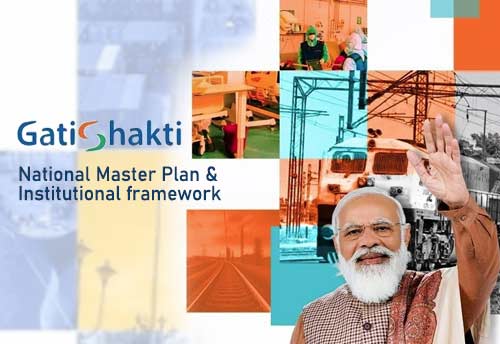Programs in News: PM launches Gati Shakti- National Master Plan for infrastructure development. Finance Minister announced first-ever outlay of Rs 20,000 crore in the Budget for FY22-23 for PM Gati Shakti National, a Rs 100-lakh-crore project.
Programs and Policies are importance part of Economics and Social Issue, Agriculture and Rural Development section of RBI Grade B and NABARD Grade A Exam respectively. Covering Government schemes directly from source is very much needed but not easy to do, through this article we are solving this problem for you. Read our Programs and Policies related articles on regular basis to gain knowledge about these schemes for RBI Grade B, NABARD Grade A Exam and even for UPSC Civil Service exams.
- It will incorporate the infrastructure schemes of various Ministries and State Governments like Bharatmala, Sagarmala, inland waterways, dry/land ports, UDAN etc.
- Economic Zones like textile clusters, pharmaceutical clusters, defence corridors, electronic parks, industrial corridors, fishing clusters, agri zones will be covered to improve connectivity & make Indian businesses more competitive.
- It will also leverage technology extensively including spatial planning tools with ISRO imagery developed by BiSAG-N (Bhaskaracharya National Institute for Space Applications and Geoinformatics).
- Empowered Group of Secretaries (EGOs)
- Network Planning Group (NPG)
- Technical Support Unit (TSU)
- The EGOS has been mandated to review and monitor implementation of the PM GatiShakti to ensure logistics efficiency
- It is empowered to prescribe framework and norms for undertaking any subsequent amendments to the Master Plan
Further, in view of the complexities involved in overall integration of networks, enhancing optimization to avoid duplication of works for holistic development of any region as well as reducing logistics costs through micro-plan detailing, the Technical Support Unit (TSU) is approved for providing the required competencies.
- The master plan takes a holistic approach to sector-specific developments by integrating 16 ministries in a joint committee to implement and monitor Rs. 100 lakh crores of investment.
- In the Telecommunication sector, a total length of 35,00,000 km of optical fiber cable network is to be laid down by 2024-25. Connecting all 2,50,000 Gram Panchayats with high-speed internet and 4G mobile connectivity by 2022.
- New and Renewable Energy sector capacity is to be increased from 87.7 Gigawatt to 225 Gigawatt by 2024-25. 50 per cent of India’s power generation capacity is to be met by renewable energy sources by 2024-25.
- Power transmission network is to be upgraded from 4,25,500 circuit km to 4,54,200 circuit km by 2024-25. Transmission network performance parameters to match the best global standards.
- In Petroleum and Natural Gas sector, 17000 km long trunk pipeline, connecting major demand and supply centres for industries, is to be added by 2024-25 making a total length of 34500 km of pipeline across the country. All states to be connected with the trunk natural gas pipeline network by 2027
- Powered by Bharatmala, in the road transport and highways sector two lakh km route of national highway network to be achieved by 2024-25
- Powered by Regional Connectivity Scheme – UDAN, civil aviation sector to see an increase in the aviation footprint globally. 220 airports, heliports and water aerodromes to be operational by 2024-25
- Powered by Sagarmala, shipping sector to see an increase in cargo capacity at the ports to 1759 Million Metric Tonnes per Annum (MMTPA) by 2024-25 from 1282 MMTPA in 2020.
- By 2024-25, Indian Railways to see a decongestion by 51 per cent due to completion of critical project
- For promotion of industry and internal trade, 11 industrial corridors comprising 32 nodes/ projects to be developed in four phases by 2024-25
- 90 textile clusters/mega textile parks to be developed by 2024-25. Ten mega integrated textile regions/parks to have plug and play facilities, common facilities and integrated value chain
- 109 pharma and medical device clusters to be developed by 2024-25. Ten pharma clusters to be developed by financing common facilities worth Rs. 20 crore each.
- For electronics manufacturing, 38 Electronic Manufacturing Clusters (EMCs) to be developed by 2024-25.
- By 2024-25, two defense corridors to be developed with a target investment of over Rs. 10000 crore each. A turnover of Rs. 170000 crore including export of Rs. 35000 crores in aerospace and defense goods and services to be achieved by 2024-25.
- By 2024-25, 197 mega food parks and agro processing centers to be developed increasing the food processing and preservation capacity from 222 lakh MT to 847 lakh MT
- By 2024-25, 202 fishing clusters/fishing harbors and major fishing landing centres to be developed with an additional fish production of 70 lakh metric tonnes and doubling of fisheries exports.
Also Read: LiFE Movement- Lifestyle for the Environment
Also Read: Agnipath scheme for Armed Forces
Also Read: What is Jan Samarth portal?
Also Read: Ayushman Bharat Digital Mission and eSanjeevani
Also Read: PM CARES for Children scheme
Also Read: Prime Minister’s Employment Generation Programme (PMEGP)



